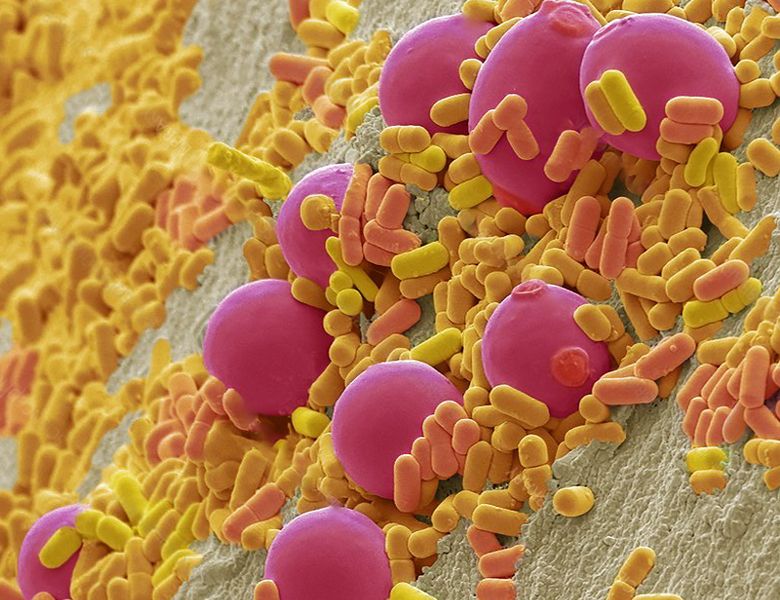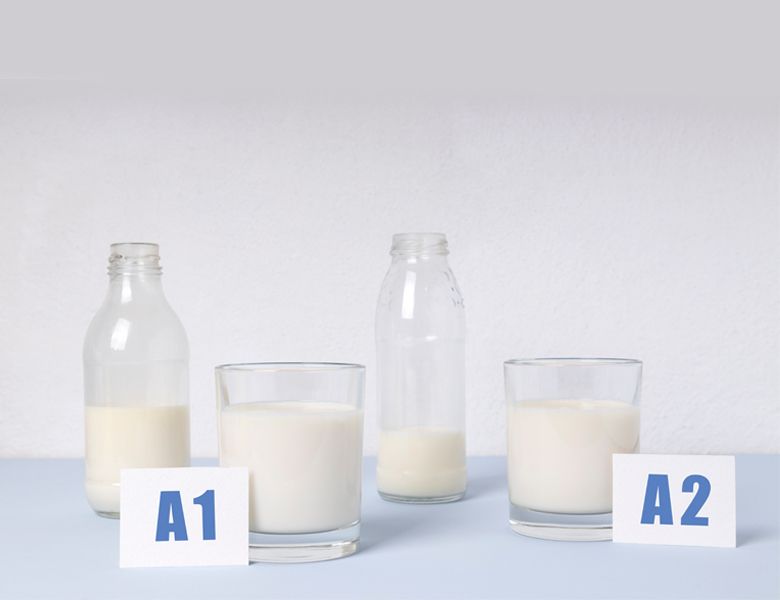Fermented Dairy Products

- | آتاماد |
- Viewer: 6712
Fermentation is a completely old process. Humans have been consuming fermented food for 10,000 years. Fermented dairy products, especially cheese, have been used for thousands of years to maintain milk shelf life, better transport, less
perishability, and better availability and digestion. This processing of milk was an important development in early agriculture, which can be attributed to the sixth millennium BC (before Christ) in northern Europe.
Milk was the first food that nature provided to humans when they came in contact with it. During most of the evolution of human history from 200,000 years BP (before Present) up to15,000 BP, the only source of breast milk for the newborn. Thus, the human decided to use domestic animals for more milk supply. At first goat milk and then sheep (about 13,000 years before present), then cow (90,000 years before present), and other mammals were made available to humans for the necessary nutrients.
Dairy products are rich in calcium, phosphorus, protein and micronutrients.
Fermented dairy products are obtained from fermented milk through suitable and harmless microorganisms. In addition to lactic acid bacteria, fermented dairy products have bioactive compounds as well as bacteria-derived metabolites that are produced during fermentation. These products, due to their special properties, are an excellent matrix for the incorporation of ingredients or nutrients that give the final product properties beyond pure nutrition. As much attention has been paid to fermented dairy products in healthy diets. People from different cultural backgrounds have been consuming these fermented dairy products for thousands of years. Because fermented dairy products are considered not only as food but also as a complete food in terms of nutrition with many health benefits. Health-promoting properties have led to a significant increase in the consumption and popularity of fermented dairy foods in recent years, including yogurt, kefir, cheese, sour cream, buttermilk, butter, and buttermilk, and the market for these products is expanding daily.
In the fermentation process, in addition to the production of lactic acid, the production of other compounds produced by lactic acid bacteria into bacterial strains has the conditions and environment of the fermentation process. For example, it can be said; Triglyceride lipolysis is not a significant activity; because lactic acid bacteria do not have lipase, but it has a proteolytic activity of casein that releases amino acids and peptides.
The most common types of lactic acid bacteria used to ferment milk are:
• Streptococcus thermophiles.
• Bifidobacteria, such as Bifidobacterium lactis, Bifidobacterium longum, and Bifidobacterium animalis.
• Lactobacilli such as Lactobacillus acidophilus, Lactobacillus rhamnosus, Lactobacillus johnsonii and Lactobacillus casei.
• Lactococcus lactis subsp. Lactis and Lactococcus lactis subs. Cremoris
It should also be noted that in recent decades, the therapeutic and preventive effects of fermented dairy products on diseases due to the wide range of these products in the food industry have been studied. Numerous studies and clinical trials performed on fermented dairy products; showing that fermented dairy products have functions such as building muscle, regulating the immune system, anti-cancer effect, hypocholesterolemic agents, and antioxidants as well as lowering blood pressure and osteoporosis, tooth decay, diabetes, and obesity. Also, fermented dairy products, both topically and orally, have beneficial effects on skin health.
According to scientific evidence, fermented dairy products are one of the best natural ingredients that are used as an effective treatment and in turn have fewer side effects.
Yogurt
Yogurt is one of the most popular dairy products that humans have been consuming for centuries. The most common milk used in yogurt is cow's milk. But goat, ewe and milk is also used in local areas.
Yogurt is an important source of nutrients, proteins, carbohydrates and several vitamins (B2, B6, and B12).
Per capita consumption of yogurt has been increasing in most countries over the past few decades, and due to the high demand for this product, different types of it have been available in the market. Types of yogurt include set or stirred yogurts, fruit and flavored yogurts, drinking yogurts as well as low-fat yogurt, concentrated yogurt, probiotic and processed yogurt or soy milk.
After the heat treatment of the milk base is cooled to the it to the optimum temperature of bacteria (40-45 ° C). The function of the bacteria is to ferment milk sugar (lactose), which is converted to lactic acid, and the pH of milk is also reduced. During milk acidification, the pH decreases from 6.7 to ≤4.6. The formation of gel-like structure and yogurt texture occurs at a pH between 5.4-5.2.
During the yogurt fermentation process of yogurt, with activity of lactic-producing bacteria (Lactobacillus delbrueckii subsp. Bulgaricus and Streptococcus subsp. thermophilus.), and fermentation of lactose, it also affects milk proteins and improves the texture and taste of yogurt. Most flavoring compounds in yogurt come from the lipolysis of milk fat and the production of citrate.
These compounds are divided into four categories:
• Volatile carbonyl compounds (acetaldehyde, acetone, acetone and dactyl)
• Non-volatile compounds (lactic, pyruvic, oxalic and succinic acid)
• Acid volatile compounds (acetic, butyric and propionic acid)
• Other compounds (specific amino acids or compounds formed by the thermal process of protein, fat and lactose)
Metabolites of lactic acid bacteria, such as carbonyl compounds, volatile acids, and exopolysaccharides, also greatly affect the quality of yogurt.
Natural hydrocolloids such as exopolysaccharides (EPS) with stabilizing and tissue-strengthening properties can be useful in increasing the desired properties of yogurt. In addition, EPS enhances the various functional properties of yogurt, such as its antioxidant and prebiotic potential. EPS can provide physical and microstructural stability, which in turn increases protein distribution and viscoelastic properties in yogurt.
Some of the benefits of yogurt:
• Intestinal health
• Strengthens the immune system due to the presence of magnesium, selenium and zinc
• Tooth and bone health due to high calcium content
• Prevent heart disease due to the presence of vitamin B12 and B2 (Riboflavin)
• Regulation of blood pressure
• Regulation of metabolism
• Bone health and reduce the risk of osteoporosis
• Weight control
Lactic butter

People have been making butter from cow's milk fat for thousands of years. Butter is not only because of its pleasant butter taste, but also because there is evidence that this dairy product has a variety of positive effects on human health. Butter is rich in vitamins E, A, K and unsaturated fats and butyrate.
Chemically, butter is an oil-in-water emulsion that contains at least 80% fat.
The technology of making butter dates back to thousands of years BC (before Christ). In the early days, sour milk was used in the production of butter due to the presence of environmental opportunistic bacteria and led to natural spontaneous fermentation. Sour milk or acidic buttermilk was then used to start fermenting the cream. This function reduced the fermentation time and improved the quality of fermented products. Finally, it became possible to produce safe and compatible butter with high quality and under controlled conditions using pure primary cultures.
The butter machine maker was a turning point in the production of butter from small scale to large scale. The quality of the butter produced increased further with the pasteurization and advancement of lactic starter technology. The size and distribution of water droplets in butter is of particular importance for the safety and quality of butter. In fact, with the advancement of butter technology, manufacturers can change the spreadable properties to meet the needs of consumers. In summer, milk fats contain large amounts of unsaturated fatty acids with a lower melting point, and in contrast, winter milk has a higher proportion of solid fat.
At present, butter is usually classified into two categories: butter (sour cream) and butter (sweet cream), each of which has a specific taste. Butter can also be classified according to the amount of salt. No salt, salt and butter with added salt. In addition, by adding spices and herbs and condiments, flavored butter can be produced for use in bread or desserts.
Cultured butter or sour cream is described as lactic butter. To produce lactic butter, the cream is inoculated with pasteurized lactic acid after pasteurization. The cream is then allowed to ferment, during which aromatic compounds are produced. Sweet cream is made from standard non-fermented cream with about 40% fat.
Butter has been popular for thousands of years because of its aromatic flavors, which depend on the animal's nutrition, production temperature, and storage conditions of the final product. Although more than 230 volatiles have been identified as natural components of butter, only a small fraction of them contribute to the aroma of butter. For example, dactyl has a butter-like taste and a butanoic acid has cheesy aroma.
Lactic butter is usually produced by adding mesophilic bacteria as primary cultures. These mesophilic are more active in the temperature range of 15 to 40 ° C. LAB are responsible for producing dactyl and other aromatic compounds in butter when fermenting cream.
During the production of lactic butter, the LAB metabolize the sugars in the butter and produce lactic acid through homo or hetero-formant pathways. The performance of the LAB is mainly based on their ability to metabolize certain components of milk during specific biochemical processes such as glycolysis, proteolysis, lipolysis and dactyl production. LAB also metabolize other substrates, including citrate-producing 4-carbon compounds. Dactyl or 2,3-butandione is one of the most important aromatic substances among the 4-carbon compounds produced by citrate metabolism and is responsible for the aroma of dairy products such as butter, sour cream and cream cheese. Dactyl is the end product of citrate metabolism by specific LAB such as Lactococcus lactis-Lactis biovar and diastylactis and Leuconostoc.
Citric acid is a precursor to dactyl, which is present in approximately 2000 mg/L in cow's milk. Leuconostoc species reduce acetaldehyde produced by lactococci by producing dactyl. The highest rate of citrate conversion was observed at pH=5/5-6, when citrate was added to the culture.
Probiotic beverages
The term “Probiotics” is derived from a Greek word that means “for life” and is used to describe living non-pathogenic organisms which exert positive effects on their hosts. Vergin was the first scientist to introduce “Probiotics”. While he was studying the negative effects of antibiotics and on the gut microbial population, he noticed that probiotic was favorable to the gut microflora. Subsequently, World Health Organization (WHO) in October 2001 defined probiotics as "live microorganisms which when administered in adequate amount confer a health benefit on the host.". Following this definition, the guidelines for the evaluation of probiotics in food were released by the Food and Agriculture Organization (FAO) and WHO in May 2002. However, a revised simplified definition was proposed by World Gastroenterology Organization (WGO) which says “probiotics are live microorganisms that confer a health benefit on the host when administered”.
Yogurt, fermented milk, and cheese have long been consumed as probiotic dairy foods. As for probiotic drinks, probiotic dairy-based beverages were the first commercialized functional dairy beverages and supplemented with value-added ingredients such as vitamins, minerals, probiotics/prebiotics, etc., occupying the largest place within the functional dairy beverages market. Some traditional dairy beverages have been widely consumed in different parts of the world and have a sound scientific background of functional properties and a healthy image. Among traditional dairy beverages, kefir is believed to be the first functional dairy product. It has been proved that the longevity of the Caucasian people is attributed to the consumption of kefir. Koumiss is another dairy drink with ancient roots and might cure many illnesses including tuberculosis, disorders of stomach and colon, and hepatitis.
It is believed that the beneficial bacteria taken into the human body through foods can modulate the gut microflora and improve the health status of regular consumers of such foods. Numerous studies have demonstrated the beneficial effects of probiotic dairy-based products on animals. Numerous studies, for example, showed that continuous consumption of probiotics improves the cardiovascular parameters of model animals. There is, also, some evidence about the positive effects of probiotic dairy products on the human cardiovascular system. Other researches, moreover, suggested that improved blood lipid profiles, weight loss, reduced intestinal damages, and preventing kidney stone development in animals were all attributed to the consumption of probiotic dairy-based products.
A study conducted in Sweden showed an increase iron absorption by approximately 50% in healthy women of reproductive age. Iron absorption from a fruit drink that is enriched by adding 109 CFU (colony-forming unit) Lactobacillus plantarum 299v (Lp299v), and 1010 CFU Lp299v were compared with that from a control drink without Lp299v. It was demonstrated that mean iron absorption from the drink containing 1010 and 109 CFU Lp299v was significantly higher than that of the control drink, 29·1%, 28·6%, and 18·5% respectively. The possible mechanism related to enhancement in iron absorption may be attributed to the colonization of Lp299v in the intestine. Another possible mechanism underlying an increase in colonic iron absorption could be related to a decrease in colonic pH, thus reducing ferric iron into highly absorbable ferrous iron as a result of lactobacilli growth.
Ayran
Ayran or Doogh is a savory yogurt-based beverage, which is popular across Western Central, and South Asia, Southeastern, and Eastern Europe which is normally served chilled. Ayran is a traditional Turkish fermented non-alcoholic drink and made up of three main ingredients: yogurt, which can be either homemade or industrially produced by adding Streptococcus thermophilus and L. delbrueckii subsp. bulgaricus to standardized milk for fermentation, water (30–50%), and salt (0.5–1%). Ayran is sometimes optionally seasoned with herbs such as mint and celery. Some varieties, also, are carbonated.
Fermented food products have beneficial effects on health, playing a key role in the human diet around the world. Fermentation is one of the oldest methods used in food preservation. The earliest records show that humans were consuming ‘soured milk’ as long as 2000 years ago. The beneficiary health effect of fermented milk products on humans is well established. In addition, fermentation enhances mineral bioavailability and the digestibility of proteins and carbohydrates.
Homemade ayran is made daily and consumed fresh. Industrial ayran, however, can be produced by two different methods, by the addition of water to either yogurt or milk. As for the second technique, first water is added to milk and then diluted milk is fermented. The industrially produced ayran microbiota is more stable in comparison to the homemade one. Moreover, the contamination risk of homemade ayran is very high.
The shelf life of ayran is limited to 10-15 days at 4°C. Extending its shelf life by applying any heat treatments or other processes is not recommended because such processes would negatively affect the number of yogurt bacteria.
Ayran is a highly valued drink that can be digested easily with high content of vitamins and calcium. In addition, there is a possibility to develop its functional properties, for example, by addition of inulin as prebiotic and L. acidophilus and Bifidobacterium spp. as probiotic strains to ayran, a product with good appearance, taste, and higher Lactobacillus bacteria count would be produced.
Some problems related to starter cultures in the industrial ayran production process are as follows. Some strains of L. delbrueckii subsp. bulgaricus used as starter cultures can produce bitter peptides, which can lead to a bitter flavor in turn. During storage, starter cultures can continue to produce lactic acid, causing an objectionable sharp and acid taste. In terms of selection of culture, phage sensitivity of starter cultures is an important issue, as well. Phage infection of starter cultures can cause a negative impact on the functionality of starter cultures.
References
- https://www.sciencedirect.com/science/article/pii/S1756464620302838
- https://www.frontiersin.org/articles/10.3389/fmicb.2020.01794/full?report=reader
- https://books.google.com/books?id=zMCDLlcRaQkC&printsec=frontcover#v=onepage&q&f=false
- https://www.researchgate.net/profile/Hilton-Deeth/publication/311343388_Yogurt_Technology_and_Biochemistry/links/58dcf502a6fdcc7c9f5a22ee/Yogurt-Technology-and-Biochemistry.pdf
- https://academic.oup.com/ajcn/article/80/2/245/4690304?login=true
- https://www.sciencedirect.com/science/article/pii/S0022030220310274
- https://www.sciencedirect.com/topics/food-science/yogurt
- https://onlinelibrary.wiley.com/doi/10.1002/9781118534168.ch16
- https://www.sciencedirect.com/science/article/abs/pii/S0141813021011156
- https://pubmed.ncbi.nlm.nih.gov/30506248/
- https://pubmed.ncbi.nlm.nih.gov/26061422/
- https://www.yogurtinnutrition.com/tag/fermented-food/
- https://civilica.com/doc/957547/
- Schlundt, Jorgen. "Health and Nutritional Properties of Probiotics in Food including Powder Milk with Live Lactic Acid Bacteria" (PDF). Report of a Joint FAO/WHO Expert Consultation on Evaluation of Health and Nutritional Properties of Probiotics in Food Including Powder Milk with Live Lactic Acid Bacteria. FAO / WHO. Archived from the original (PDF) on October 22, 2012. Retrieved 17 December 2012.
- Moura, C. S., Lollo, P. C. B., Morarto, P. N., Esmerino, E. A., Margalho, L. P., SantosJunior, V. A., Amaya-Farfan, J. (2016). Assessment of antioxidant, lipid profile, general biochemical and immune system responses of Wistar rats fed with dairy dessert containing Lactobacillus acidophilus La-5. Food Research International, 90, 275–280. .
- Hoppe M, Önning G, Berggren A, and Hulthén L. (2015). Probiotic strain Lactobacillus plantarum 299v increases iron absorption from an iron-supplemented fruit drink: a double-isotope cross-over single-blind study in women of reproductive age. doi:10.1017/S000711451500241X
- A S, Bidlack W R, Clemens R A. (1999). Probiotic spectra of lactic acid bacteria (LAB), DOI: 10.1080/10408699991279187
- Altay F, Karbancıoglu-Güler F, Daskaya-Dikmen C, Heperkan D. (2013). A review on traditional Turkish fermented non-alcoholic beverages: Microbiota, fermentation process and quality characteristics.
GET IN TOUCH
Copyright © 2023 Atamad.com All right reserved
Website design and SEO services by Seohama team – Web hosting by Sarverhama
Copyright © 2023 Atamad.com All right reserved
Website design and SEO services by Seohama team – Web hosting by Sarverhama








